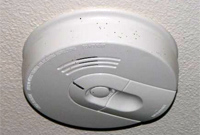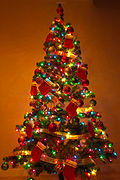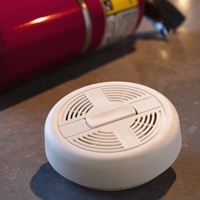Fire Safety
Turn Your Clocks Back and Check Smoke Alarms, Carbon Monoxide Detectors
 Nov. 4 is when we turn back the clocks, the usual sad good-bye to another summer and fall. At Breakstone, White & Gluck, we suggest taking a few of the extra minutes you gained to replace the batteries in your home’s smoke alarms and carbon monoxide detectors. Check whether the devices are working properly and replace them if needed.
Nov. 4 is when we turn back the clocks, the usual sad good-bye to another summer and fall. At Breakstone, White & Gluck, we suggest taking a few of the extra minutes you gained to replace the batteries in your home’s smoke alarms and carbon monoxide detectors. Check whether the devices are working properly and replace them if needed.
Smoke Alarms
Massachusetts requires a smoke alarm be installed on every habitable level of a residence as well as on the basement floor. The law requires two types of smoke alarms: photoelectric and ionization. Only photoelectric smoke detectors are to be installed within 20 feet of kitchens and bathrooms with showers. Ionization alarms are more sensitive and more likely to be disabled in these areas. Outside the 20-foot zone, both photoelectric and ionization alarms are required.
Carbon Monoxide Detectors
Carbon monoxide is a colorless, odorless, tasteless gas which can emerge without any warning. In a home, it could be caused by a gas leak in a furnace or other appliance. Early symptoms may include headache and dizziness, though inhalation can quickly lead to serious injuries, seizures, comas and death.
In Massachusetts, residences are required to have working carbon monoxide alarms on every habitable level of the home or dwelling unit. You can purchase an individual carbon monoxide detector or a dual smoke alarm and carbon monoxide detector.
If you have questions, your local fire department is a good resource for information, along with the manufacturer of your devices.
Read More
Portable Generator Tips for Hurricane Sandy
As Hurricane Sandy moved toward Massachusetts this weekend, many people purchased portable power generators. This equipment is an inexpensive way to find comfort during a power outage, but it is important to remember the potential safety hazards when not used properly.
The most frequent danger associated with portable generators is carbon monoxide poisoning, which can result from a leak or misplacement of a power generator in a house or garage where gas can accumulate. Carbon monoxide is a colorless, odorless and tasteless gas and poisoning can occur without warning. Symptoms often start with headaches and dizziness, but can quickly advance to seizures, coma and death.
If you have purchased a portable generator for the storm, the lawyers at Breakstone, White & Gluck offer these tips for safe use against carbon monoxide poisoning, as well as burns and electrocution:
Use your portable generator outside. Set it up away from your home’s doors, windows and vent openings.
Never use a portable generator inside your home. Also do not use it in an attached garage, even in a garage with an open door.
Check your carbon monoxide detector. Make sure the detector and batteries are working. Follow the manufacturer’s instructions for placement as well as state law, which in most cases requires residences to have carbon monoxide detectors on every habitable level of the home or dwelling unit. Check if your portable generator manufacturer offers additional instructions.
Make sure there is a safe connection. Take time to learn the proper way to connect the portable generator to your appliances.
Refuel safely. Turn off your portable generator and let it cool before refueling and turning it back on.
Fuel storage. Store your portable generator fuel in a clearly marked container. Store it outside living areas.
Read the manufacturer’s instructions. These instructions should provide details about how you can expect the device to operate during the critical storm conditions.
No backfeeding. Never try to power the house by “backfeeding”, the practice of plugging the generator directly into a wall unit or household wiring. This creates an electrocution risk to yourself as well as neighbors and utility workers using the same utility transformer. It also bypasses some of the built-in household circuit protection devices.
Do not operate in the rain or wet conditions. You may have purchased a portable generator to make it through the storm, but you should only operate the generator in dry conditions. If you must operate in wet conditions, the Consumer Product Safety Commission (CPSC) recommends placing it under an “open, canopy-like structure on a dry surface.”
Related:
Portable Generator Hazards, Consumer Product Safety Commission.
MEMA offers tips as Hurrican Sandy approaches, Massachusetts Emergency Management Agency (MEMA).
Read More
Decorating Safely for the Holidays
 While it is the most wonderful time of the year, the holiday season is also a prime time for home fires.
While it is the most wonderful time of the year, the holiday season is also a prime time for home fires.
In Massachusetts, from 2002 to 2007, Christmas Day saw the second most number of residential fires of any day while Christmas Eve ranked ninth, according to the Office of the State Fire Marshal. The majority of these fires can be prevented with planning and awareness.The Boston injury lawyers at Breakstone, White & Gluck offer these tips to help you and your family enjoy the season safely:
Christmas Tree Watering
- Do not pick up your Christmas tree immediately after Thanksgiving.
- Make sure you have an adequate size tree water stand.
- Learn how much watering your tree needs. In general, you should use one quart of water per day for each stem diameter. Ask your local fire department for more instructions.
- Remove your tree in a timely manner to avoid letting it dry out. Many communities offer special Christmas tree pickups after the holiday.
- Another option is to cut up your tree branches and place them over a garden.
- Do not leave your tree outside unattended overnight for teenagers and vandals to find.
Christmas Tree Holiday Lights
- Keep your tree at least three feet away from flame or heat sources, such as fireplaces and radiators. These pose a fire risk and will dry out your tree faster.
- Never put candles on or near your tree.
- Check your Christmas tree lights for broken bulbs. If one is damaged, remove the whole string to avoid a fire accident.
- Make sure your Christmas tree lights are designed for indoor use.
- Unplug Christmas tree lights when you leave the house or go to bed.
- Check if your Christmas tree lights have been tested for safety by a nationally recognized laboratory. If they have, they will be marked ETL, UL or CSA.
- Do not put too many lights on your tree. Check the box for the appropriate number of strings.
- Place your tree near a power outlet to reduce use of extension cords. Make sure extension cords have been marked UL to show they have been tested.
- If you have an artificial tree, check to see if it has the label “Fire Resistant.”
Holiday Candles
- Use sturdy candle holders with flame-protective and non-combustible shades or globes.
- Never leave burning candles unattended.
- Place burning candles in the center of tables.
- Place burning candles at least four feet away from curtains, bedding and other flammables.
- Keep candles and matches away from children.
- When lighting candles, secure hair and clothing away from candles to prevent injuries.
- If you are lighting multiple candles, make sure you are aware of how much heat they generate.
Cooking a Safe Thanksgiving Dinner
 At Thanksgiving, the focus is on enjoying good food and family. But attention must also be paid to fire safety because Thanksgiving sees more residential fire deaths, injuries and property damage than any other day of the year.
At Thanksgiving, the focus is on enjoying good food and family. But attention must also be paid to fire safety because Thanksgiving sees more residential fire deaths, injuries and property damage than any other day of the year.
These fires are preventable with solid planning and good communication among those who are preparing the meal and others in the home. The Massachusetts personal injury lawyers at Breakstone, White & Gluck of Boston offer these tips to keep your holiday safe:
- Never leave food cooking unattended. If you have to leave the kitchen, turn the stove off or ask someone to watch the food.
- Make sure you have properly working smoke alarms near your kitchen.
- Keep oven mitts, wooden utensils, towels and other materials away from the stovetop.
- Use a timer to remind you when to stop cooking.
- Avoid using candles, especially near young children.
- Make sure cords to electrical tools and appliances, such as electric knives, are not dangling within reach of a child.
- Make sure children stay away from liquids and soft foods such as gravy and vegetables until they cool down. If these foods are too hot, they can cause skin burns.
What To Do If You Have A Cooking Fire
Keep a small fire extinguisher handy in your kitchen, either under the sink or close by in a closet. Inspect it periodically and make sure it is properly charged. If you have a cooking fire, it is best to call 911, wait outdoors for the fire department.
If it’s an oven fire, turn off the heat and keep the door closed. For small grease fires, smother the fire by sliding the lid over the pan and turning off the stove top. Leave the pan covered until it is cool. Never use water to extinguish a grease fire. You could be badly burned.
If you try to put out the fire, be sure everyone else is out of the home and you have a clear exit path.
Read More
Change Your Smoke Alarm Batteries for Daylight Saving Time
 On Sunday, Nov. 6, we turn clocks back an hour as Daylight Saving Time ends. The change from Daylight Saving Time is an important reminder to protect our family and homes by checking and changing the batteries in our smoke alarms and carbon monoxide detectors.
On Sunday, Nov. 6, we turn clocks back an hour as Daylight Saving Time ends. The change from Daylight Saving Time is an important reminder to protect our family and homes by checking and changing the batteries in our smoke alarms and carbon monoxide detectors.
Fire and carbon monoxide poisoning are great concerns as the cold weather arrives and residents make their home heating decisions. Each year, more than 150 people in the United States die from accidental non-fire related carbon monoxide (CO) poisoning. This poisoning is associated with consumer products, such as furnaces, stoves and water heaters.
Even more people die each year in fires. In 2010, 3,120 people were killed while another 17,720 suffered fire-related injuries, according to the National Fire Protection Association. Four out of five civilian fire deaths occurred in the home. These statistics make your work to prepare your home for the winter especially important.
Smoke Alarms: Massachusetts requires a smoke alarm be installed on every habitable level of a residence as well as the basement floor.
There are two types of smoke alarms, photoelectric and ionization. Effective April 5, 2010, only photoelectric smoke detectors are to be installed within 20 feet of kitchens and bathrooms with showers. These alarms are less sensitive and the goal is to reduce nuisance alarms that cause people to disable devices. Both photoelectric and ionization alarms are required in all other areas.
Carbon Monoxide Detectors: Since March 31, 2006, residences have been required to have working carbon monoxide alarms on every habitable level of the home or dwelling unit. Carbon monoxide is a colorless and odorless gas that results from incomplete burning of fuels. The first symptoms of poisoning are similar to the flu and include headache, fatigue and dizziness.
The requirements for meeting the smoke alarm and carbon monoxide detector laws can be met with separate units or with smoke alarms that have carbon monoxide detectors.
Read More

